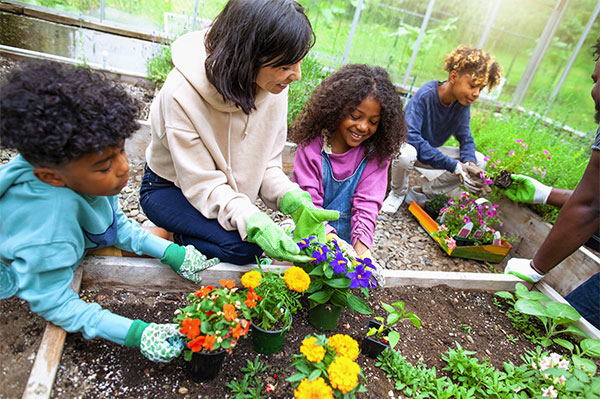Seasonal Gardening Tips to Maintain Your Yard Flourishing Year-Round
Expert Gardening Tips for Developing a Lasting and Eco-Friendly Garden
Getting started on the journey to produce a green and sustainable garden entails a series of intentional selections and practices that not only boost the beauty of your area however additionally contribute positively to the setting. To reveal more professional understandings and sensible strategies, let us check out the crucial components that specify an environmentally conscious garden.
Select Native Plants
Selecting indigenous plants for your yard is an essential action towards achieving sustainability. Furthermore, native plants generally require less water as soon as developed, adding to much more efficient water usage.
Past their sensible advantages, native plants play a vital function in supporting local biodiversity. They provide essential environment and food resources for native wild animals, consisting of pollinators such as birds, butterflies, and . This fosters a balanced ecosystem, which is essential for the health and wellness of your garden and the surrounding environment.

Implement Water Preservation
Implementing water conservation techniques is vital for preserving a lasting yard. Reliable water use not just decreases the ecological impact but also guarantees that plants get appropriate hydration without waste.
Furthermore, mulching is a useful method for saving water. By applying a layer of organic compost, such as timber chips or straw, around the base of plants, garden enthusiasts can minimize soil dissipation and keep consistent moisture levels. Mulch additionally helps regulate soil temperature and suppresses weed growth, more contributing to plant health and wellness.
Rain harvesting is another lasting strategy. Installing rainfall barrels or various other collection systems permits gardeners to keep and capture rain, which can later on be utilized during completely dry durations. This not only preserves local water however also gives an all-natural, chemical-free source for watering.
Finally, selecting drought-tolerant plant varieties can substantially minimize water needs. These plants are adapted to grow in low-water conditions, making them ideal for eco-friendly yards. gardening tips. Carrying out these water conservation techniques will cultivate a resilient, lasting garden
Usage Organic Gardening Techniques

Pest management in an organic garden counts on integrated insect administration (IPM) methods. These include encouraging useful bugs, utilizing natural predators like ladybugs and lacewings, and carrying out crop rotation to interrupt pest life cycles. Companion planting, where particular plants are expanded with each other to push back parasites or bring in valuable pests, is one more efficient method.
Weed control is managed through mulching and hand-operated elimination, instead than counting on herbicides. Mulch not only suppresses weeds but additionally preserves wetness and improves soil health as it damages down. Organic composts, such as straw, wood chips, and leaves, are especially helpful.
Produce Wildlife Habitats
Developing wildlife habitats within your yard not only enhances biodiversity yet likewise supports the ecological community's balance. Deliberately rooms that draw in and sustain neighborhood fauna, you can create a growing micro-ecosystem that benefits both plants and pets. Start by including native plants, as these are fit to your regional climate and supply vital food and sanctuary for wildlife. Indigenous plants sustains a variety of insects, birds, and little creatures, adding to the ecological network.
Consider adding a water attribute, such as a pond or birdbath, to supply a regular water source. Water aspects bring in a variety of types, from amphibians to pollinators, boosting the yard's vitality. Furthermore, setting up birdhouses, bat boxes, and insect resorts provides risk-free nesting websites and encourages biodiversity.
Leave some areas of your garden undisturbed, allowing leaf litter and fallen branches to accumulate. By prioritizing these sustainable practices, your garden can become a sanctuary for local wild animals, advertising eco-friendly wellness and sustainability.
Technique Composting and Mulching
A key facet of sustainable gardening, composting and mulching, dramatically improves soil wellness and minimizes waste. Unlike synthetic plant foods, compost enriches the dirt with vital nutrients and advantageous microbes, promoting a healthier yard ecosystem.
Mulching, on the various other hand, involves covering the dirt surface with natural or inorganic materials, such as straw, timber chips, or shredded leaves. This method provides numerous advantages: it conserves dirt moisture, reduces weed growth, and moderates soil temperature level. Mulch likewise progressively breaks down, adding organic matter to the dirt and more boosting its fertility.
To wikipedia reference exercise effective composting, ensure your compost heap has a balance of eco-friendly products (abundant in nitrogen) and brownish materials (rich in carbon), preserving appropriate oygenation and dampness. gardening tips. Frequently transforming the heap increases discover this decomposition. For mulching, apply a 2-3 inch layer around plants, ensuring it does not directly get in touch with stems or trunks to stop rot
Verdict

Selecting indigenous plants for your garden is a basic step towards accomplishing sustainability.Additionally, including native plants can boost the aesthetic allure of your garden. These plants are adjusted to flourish in low-water problems, making them perfect for eco-friendly yards. Implementing these water preservation approaches will cultivate a resilient, lasting yard.
In final thought, developing a sustainable and environment-friendly yard involves the calculated selection of native plants, the fostering of water conservation methods, and the execution of natural gardening approaches.